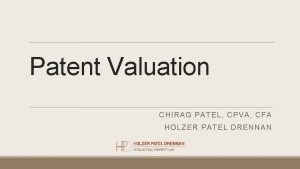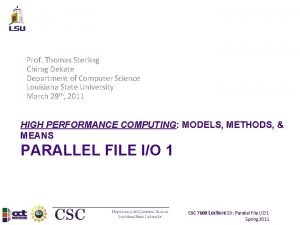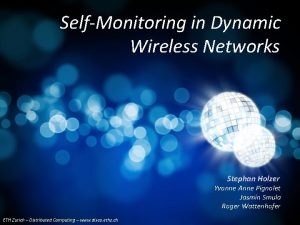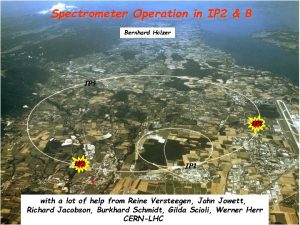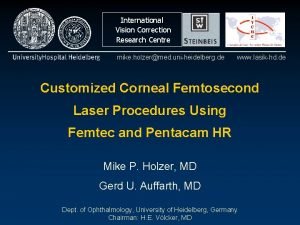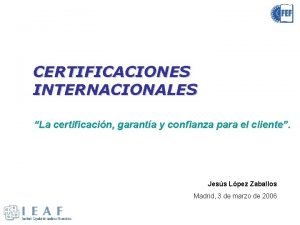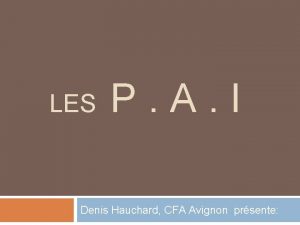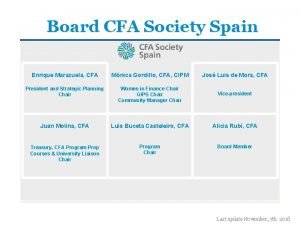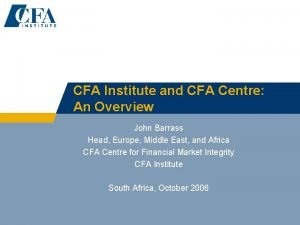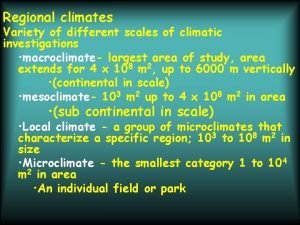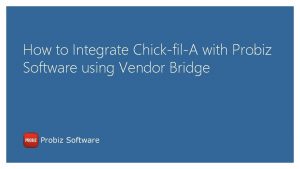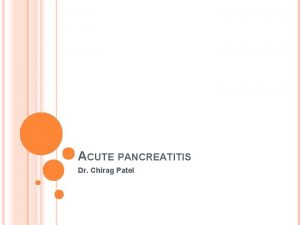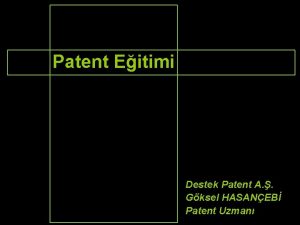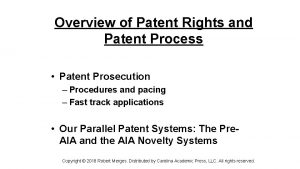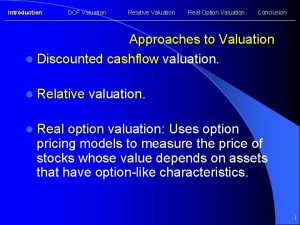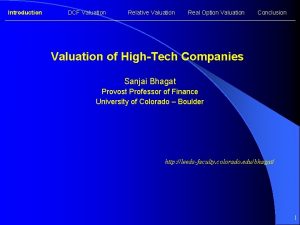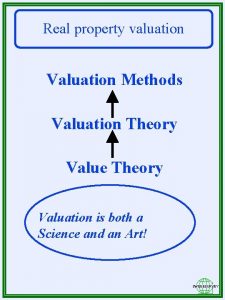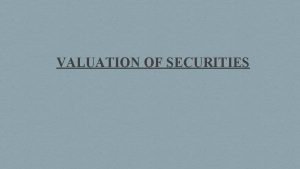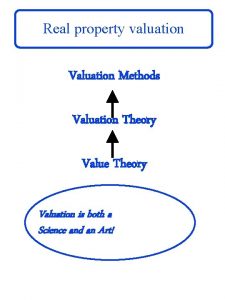Patent Valuation CHIRAG PATEL CPVA CFA HOLZER PATEL



![Summary of Valuation V* = [(CV + (S/2) + (3 * C)]N ◦ V Summary of Valuation V* = [(CV + (S/2) + (3 * C)]N ◦ V](https://slidetodoc.com/presentation_image_h2/d268e712ce702446d23bfedac1adad66/image-4.jpg)


















- Slides: 22

Patent Valuation CHIRAG PATEL, CPVA, CFA HOLZER PATEL DRENNAN

Uses for Patent Valuation ◦ Litigation ◦ Use of patents as collateral ◦ Inter-company transfer ◦ Acquisition of IP based companies ◦ Reporting on financial statements ◦ Valuation approach may defer based on the use of the patent valuation ◦ Financial reporting prudence and consistency ◦ Transfer Pricing arms length transaction, defensible, see IRS guidelines ◦ Sale (90% of patents that go to brokers do not result in sale)

How much is a patent worth? ◦ What is my house worth? Is is the cost to build? Is it based on income generation (if rental)? Market Value? ◦ Similar methods and questions for patent valuation ◦ A comprehensive valuation report will have valuation using multiple methods to support the final valuation ◦ More support for the valuation, the more likely that you can justify the value ◦ “It is better to be approximately right than to be precisely wrong” – Warren Buffet
![Summary of Valuation V CV S2 3 CN V Summary of Valuation V* = [(CV + (S/2) + (3 * C)]N ◦ V](https://slidetodoc.com/presentation_image_h2/d268e712ce702446d23bfedac1adad66/image-4.jpg)
Summary of Valuation V* = [(CV + (S/2) + (3 * C)]N ◦ V = Value ◦ CV = Calculated Value ◦ S = Story ◦ C = Competition ◦ N = Negotiating Ability * David Wanetick, CPVA

Where do we start? ◦ Most valuation methods discussed here are likely to be used with portfolio of patents ◦ Start with legal analysis of the quality of patents (number of claims, file history, etc. ) ◦ More detailed legal analysis of patents needed for smaller portfolios ◦ Separate the wheat from the chaff (Allison Analysis) and perform valuation exercise on selected patents

Allison* Analysis – 7 attributes of valuable patents ◦ Recently issued ◦ US Patents ◦ Issued to small companies or individuals ◦ Frequently cited (and has good prior art citation) ◦ Substantial prosecution (longer prosecuted more valuable) ◦ Has more claims (especially more independent claims) ◦ Mechanical, computer, and medical device companies *John R. Allison, et al. , Valuable Patents, 92 Geo. L. J. 435, 437 (2004)

Major Valuation Approaches ◦ Cost Method ◦ Market Method ◦ Comparable analysis based, stock price based, venture funding analysis based, value destruction based, profit contribution based, balance sheet analysis based, Black-Scholes model based, etc. ◦ Income Method ◦ Relief from Royalty Method

Cost Method ◦ Cost to reproduce the patented technology and patent ◦ Cost to design around ◦ Replacement cost (generate similar technology) Original R & D costs Personnel costs attributable to the project Materials & Supplies Overhead attributable to the patented technology ◦ Apportion the total between patented tech and trade secrets ◦ Bring the total to the present value based on cost of capital for the ◦ ◦

Cost Method – Considerations ◦ Cons: ◦ ◦ Cost does not equal value Simple ideas may be the most valuable Hard to determine when a project started Does not account for failed projects and learning from mistakes ◦ Pros: ◦ May be useful to start negotiation ◦ Allows inventor to see return on investment

– Analysis of Comparable Damages Market Method ◦ Find damage awards from past litigation related to comparable patents (may be hard to find) ◦ Adjust for: ◦ Patent quality differences ◦ Strength/weakness of the litigants ◦ Status of litigation (settlement discount) ◦ Adjust for inflation to present value

– Analysis of Comparable Acquisitions Market Method A comparable company with 10 patents recently sold for $70 M Adjust the acquisition value down for $10 M in synergies Adjust the acquisition value down for $10 M in tax losses Allocate the remaining value to different assets including patents If the patents accounted for 20% value: ◦ Total patent portfolio = 20% of ($70 -$10) = $20 M ◦ Value per patent = $2 M ◦ If our client has 5 patents Portfolio = $10 M ◦ ◦ ◦

– Stock Price Indication Market Method Look at change in market price in response to patent court ruling for comparable companies: ◦ If the market value of a company with comparable patent portfolio increased by $15 M in response to validity ruling for its portfolio of 5 patents Each patent = $3 M ◦ Adjust down for the fact that client’s patents are not litigated to determine value of similar patents for the client.

– Stock Price Indication Market Method Look at differences in valuation ratios of comparable companies: ◦ Companies in given industry are valued at multiple of 6 times CF ◦ A company with 5 patents in the same industry is valued at 8 * CF ◦ Peers do not have patents the higher multiple is due to the patent portfolio ◦ If client has $6 M in CF Patent portfolio = $6 * 2 = $12 M ◦ Adjust the value as per other quality considerations

Market Method – Value of Publicly Traded Patent Licensing Company Look at valuation of publicly traded licensing company ABC with similar technology: ◦ ABC’s Market Value $30 M ◦ Less debt $5 M ◦ Less cash $5 M ◦ Value attributable to patent portfolio $20 M ◦ Number of patents 20 ◦ Value of patent $1 ◦ Adjust the value for other factors

Market Method – VC funding Look at valuation increase resulting due to patents ◦ Comparable company A raised series A at valuation of $5 M ◦ Comparable company B raised series A at valuation of $13 M ◦ A has no patents and B has 4 patents ◦ Valuation attributable to each of B’s patents = ($13 -5)/4 = $2 M ◦ Adjust for other factors between the client company patents and B’s patents to derive value of client company patent

Market Method – Based on Royalty Rates ◦ Build a schedule of royalty rates for similar deals in the industry ◦ Calculate average royalty rate (may decrease over years) ◦ Determine projected remaining life for usefulness ◦ For each year of the remaining life, determine projected revenues ◦ Calculate royalties for each year based on rate and market ◦ Calculate present value of the royalties to get the patent value ◦ Adjust as per other quality considerations for client patents * does not take into account the expenses/profits

Market Method – Determining Royalty Rates ◦ Average royalty rates per industry ◦ LES publishes industry standard royalty rates (min/max/median) ◦ 25% rule: ◦ Licensor(s) should receive 25% of licensee’s net profits from the licensed IP ◦ Good for licensee as it applies to profits ◦ If multiple licensees – they share from the 25% ◦ Regression analysis based royalty rate*: ◦ RR = 0. 4117 * EBITDA margin ◦ RR = 0. 0108 + 0. 3466 * EBITDA margin * As per research papers published in LES Insights, May 2012,

Market Method –Royalty Rate Sources ◦ SEC filings ◦ Royaltysource. com ◦ KTMine. com ◦ Royaltystat. com ◦ Recap. com ◦ Les Nouvelles ◦ Court records ◦ Pharmadeals. net, pharmalicensing. com

Income Method - Considerations ◦ Basis: Value of an asset is the net present value (NPV) of the future incomes expected to be received from the asset. ◦ Factors to determine: ◦ Revenue projections in future (fraught with uncertainties) ◦ What portion is attributable to patent ◦ Remaining useful life (statutory life? economic life? ) ◦ Discounting rate (cost of capital? whose cost of capital? ) ◦ Other benefits to consider: ◦ Cost savings ◦ Strategic advantages

Advanced Valuation Models ◦ With and Without Method ◦ Patent as an option model ◦ Probabilistic models ◦ Bayesian analysis ◦ Binomial lattices ◦ Monte Carlo method ◦ Black-Scholes ◦ Real Options model

Valuation Summary Valuation of Widget Company's Patent Portfolio Methodology Calculated Value Weight* outlier Weighted Value Cost Method Income Method $ 28, 000 1 $ 28, 000 Value to XYZ Value to ABC $ $ 23, 000 24, 500, 000 1 0. 75 $ 23, 000 $ 18, 375, 000 Comparable Acquisition Method Comparable VC Method $ $ 5, 000 17, 000 Market Method Final Weighted Value * Reasons for the weights 0 Y 1. 5 $ $ 25, 500, 000 $ 23, 718, 750

Patent Valuation – international considerations ◦ US: Report at fair value = price that would be received to sell the asset based on the based information available (FASB 157). ◦ German law demands a true and fair view of the financial statement --> Even if a patent has been bought externally the asset has to be valued always by their historical costs and not their fair value. ◦ ISO patent Valuation Standards: Rejected by a number of countries including Japan, Canada, Finland, Netherlands, Spain, South Africa, the UK and the US.
 Holzer patel drennan
Holzer patel drennan Chirag uttamsingh
Chirag uttamsingh Chirag dekate
Chirag dekate Fixed income valuation
Fixed income valuation Eth
Eth Dr hans holzer
Dr hans holzer Linda holzer
Linda holzer 11yo
11yo Stephan holzer
Stephan holzer Bernhard holzer
Bernhard holzer Mike p. holzer
Mike p. holzer Mike p. holzer
Mike p. holzer Majed muhtaseb
Majed muhtaseb Ciia vs cfa
Ciia vs cfa Cfa+recyclage aerosol
Cfa+recyclage aerosol Cfa society spain
Cfa society spain Cfa contact
Cfa contact Cfa climate
Cfa climate Probiz software
Probiz software Cfa lecturer handbook
Cfa lecturer handbook Cisi or cfa
Cisi or cfa Cfa south africa
Cfa south africa Cfa society pittsburgh
Cfa society pittsburgh
